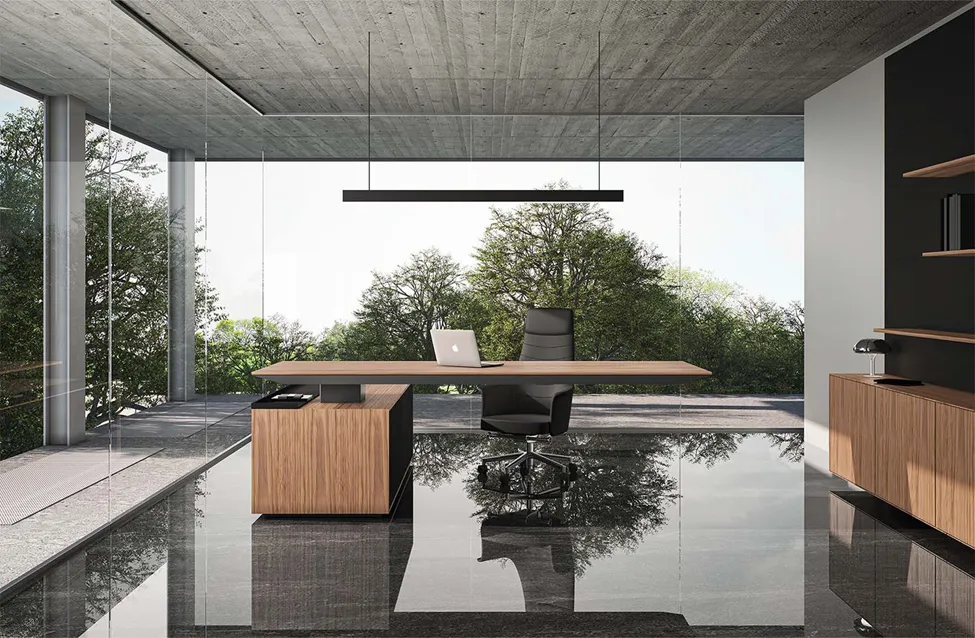Stylish Executive Desks That Combine Comfort and Functionality
Design in a professional setting is not limited to how a setting looks, but also runs into the matter of how it supports thought as well as action. This can best be seen in the choice of executive desks, where style combined with comfort and functionality makes a silent agreement to determine the rhythm of an executive. A well-designed work desk is a statement; it is a workstation reflecting current management maxim of clarity, efficiency, and the presence.
The Importance of Style in Executive Settings
First impressions count, and in an executive office, the desk is a major contributor to this first impression. A trendy desk is not only a sign of good taste; it is also an indicator of the way a leader thinks, works, and includes other people in the process.
- Visual balance: An aesthetically balanced desk serves the room and does not dominate it; it introduces unity to the distribution of the light source, color scheme, and composition.
- Purified lines and material: These would be the matte finishes or the mixed materials and the geometric character lines that make up an environment that seems purposeful and up-to-date.
- Implied organization: A neat and sleek-looking desk may subtly hint that it could be so tidy due to the internal state of order of the mind it belongs to.

Comfort That Works With You
It cannot be negotiated in terms of functionality, but it is equally essential to be comfortable. A beautiful desk that does not consider ergonomics soon turns out to be useless, particularly in the office, where working your butt off and multitasking are done regularly.
Modern executive desks are special in that they are designed to promote posture and productivity. Features such as an edged entry, adjustable surface, or well-placed drawers can make a great difference in the long term.
Leaders do not sit at one desk throughout the day. They move in and out of screens and papers, in and out of individual work and group gatherings. A desk that shifts based on these transitory states, with respect to natural gestures and decreasing strain, is not simply a surface but rather extends the way they work.
Design That Anticipates the Future
The capacity of a storage device is not the only aspect of functionality. Functionality is also about how a desk can seamlessly facilitate multiple workflows without inducing visual or physical clutter.
The most important functional characteristics of the executive desks of the present are:
- Cable management: No more tangled wires and chargers to cause incongruence to the flow of the space.
- Multi-level surfaces: To disengage digital tools and paperwork or presentation materials.
- Soft-close and secret drawers: It all started with soft-close and quiet secret drawers.
Supporting the Workspace
Although the desk is the headliner, there are other pieces that any executive workstation is not finished without. Arguably, nothing is as crucial as office chairs that come with it.
A chair and a desk should be synchronized not only by height but also by purpose.
The following are the things to take into consideration when pairing:
- Material match: Leather and wood, fabric and metal, etc – to avoid conflict, matchings must work together.
- Mobility and posture: There are chairs that have back support and adjustable height mechanisms that go in harmony with appropriately designed desks.
- Style coherence: The boldness of the desk can be balanced out with a streamlined chair, or vice versa but at all costs the visual language must be coherent.

Where Form Meets Function
When style is added to function, something strong occurs; the working environment becomes a place where people want to be, not where they feel they need to be. Such a transition can have the slightest impact on the perception of a meeting, the exchange of ideas, and the efficient use of time, but more so when backed up by office furniture that is well designed.
Where Design Supports Performance
Executive desks do more than appear good; they can facilitate easier thought, clearer vision, and easier completion. And the most focal of them all is the executive desk: it is not dull, it is not pretty, it is devoted to enhancing not only the individual, but also the procedure.
By carefully combining simple but necessary details like properly made desks set in positions that support the ergonomic process, the leaders may make the workspace work not only as a storage of instruments but also as a generator of results.

